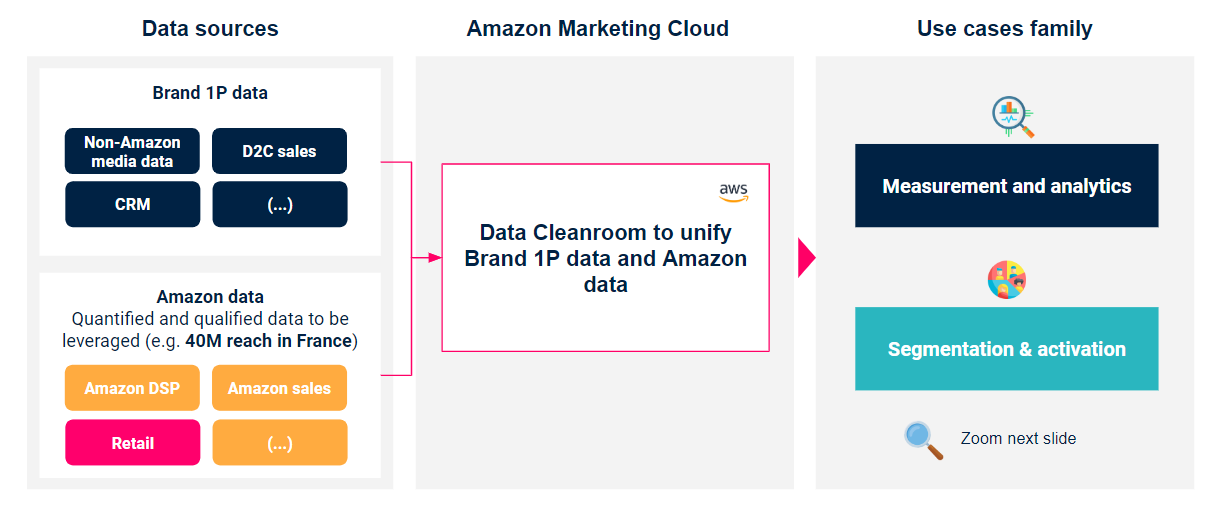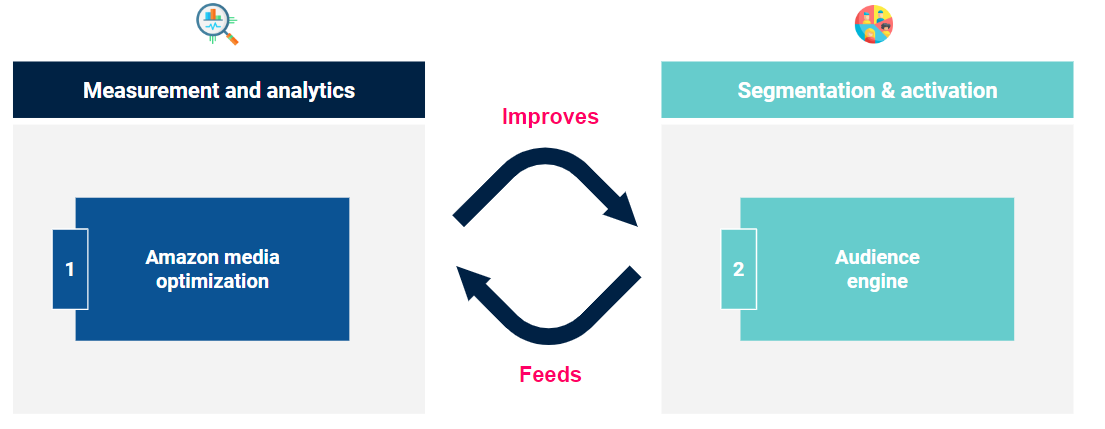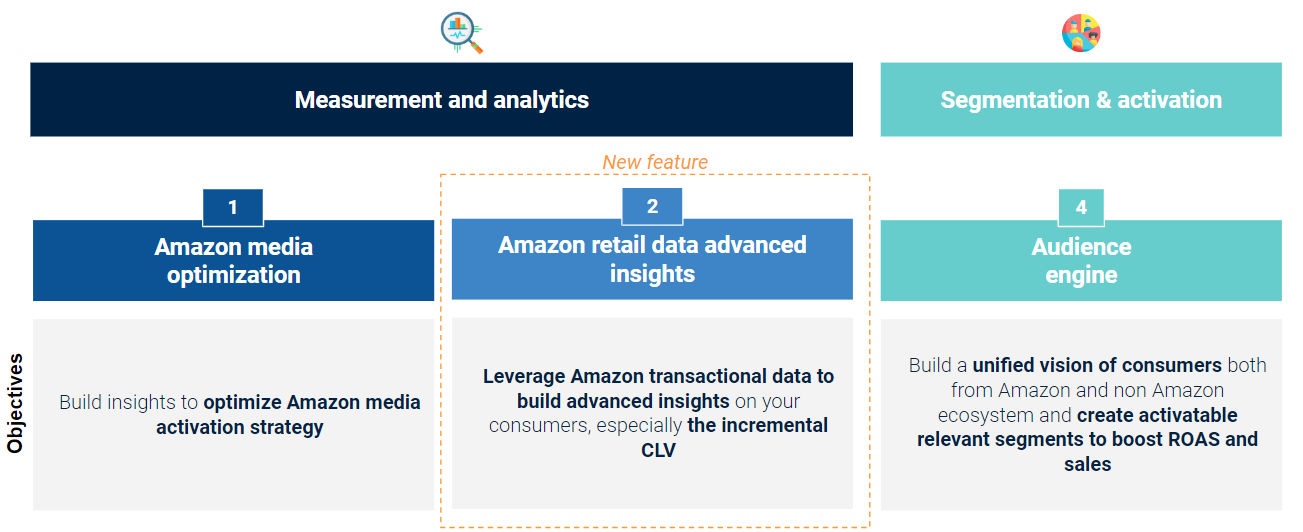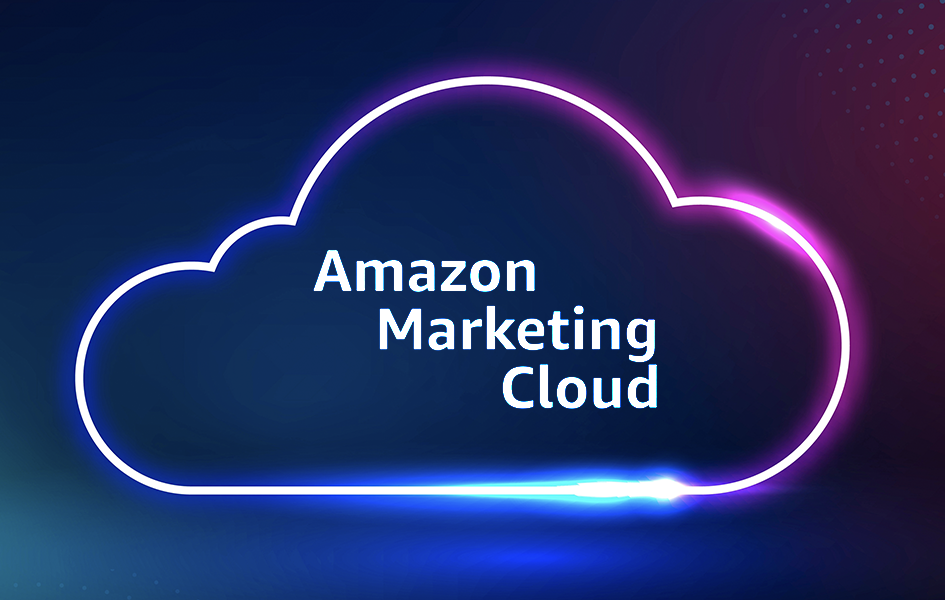Discover what our experts have to say about the new "Flexible Shopping Insights" feature just rolled out by Amazon Marketing Cloud (AMC).
You’ll learn everything there is to know about this major change that will revolutionize strategic brand deployment on Amazon.
First, a quick review of the basic principles of AMC.
What is Amazon Marketing Cloud?
AMC is a “data clean room”, a closed, secure environment where different data sources are input and cross-referenced using a common user ID. It highlights existing interactions between users of the various data sources connected to AMC (1), and leverages them through the creation of audiences based on the data collected (2).
Since 2020, only Amazon advertising sources connected to this clean room (sponsored ads and display) and advertiser 1P data can be analyzed. As a result, only a brand’s proprietary data and/or data resulting from interaction with an Amazon search campaign or exposure to Amazon display campaigns are collected, tracked and analyzed in Amazon Marketing Cloud.
Amazon Ad Server (formerly Sizmek), used in conjunction with AMC, also enables the tracking of non-Amazon data sources. This specific feature won’t be discussed here as the solution is gradually being phased out until it disappears in 2024.

What purpose does AMC serve?
The clean room is designed to help advertisers assess the relevance of an Amazon advertising campaign by answering questions such as:
However, as mentioned above, AMC also enables audience creation based on injected data. The deployment of these audiences further concretizes the operational recommendations resulting from the analyses performed.
The following are examples of audiences that can be activated:
AMC is a chance to break away from the pre-established attribution models in Amazon advertising’s search and display consoles, to better understand relationships between advertising campaigns.
Clients can then capitalize on these insights by using a tool for creating customized audiences based on identified behaviors to encourage interaction.

These initial elements fed advertisers and agencies from 2020 to 2023, but also highlighted the tool’s main limitations, namely its scope of analysis, which is limited to media campaigns.
To become the cornerstone of all strategies, including Amazon, the AMC requires a means to increase the impact of media campaigns on Amazon’s business as a whole. Flexible Shopping Insights is that means.
What is Flexible Shopping Insight?
It’s an analytical brick that exploits an additional data source in AMC. The data source that all users have been waiting for: retail data, otherwise known as organic data. The kind that doesn’t result from interaction with sponsored banners.
Given that organic data represents, on average, over 50% of data collected by sellers on Amazon, this new feature will doubtlessly have a positive impact on future analysis results.

What changes are in store for AMC?
We expect two major changes. The first is a better understanding of the impact of advertising on consumer behavior. Some advertisers complain, “Half the budget I spend on advertising is for nothing, but the problem is I don’t know which half.”
Now, they’ll know for sure. It will be possible to compare the shopping habits (number of visits, additions to basket, sales volume, etc.) of users exposed to advertising campaigns with those of unexposed users, highlighting the perceived benefit of each media campaign.
The second change is an enriched user pool that favors the creation of complex, relevant and populated audiences. No more audiences too small to be exploited: you’ll have access to all the data collected by your Amazon account to create ever more densely populated audiences, calibrated to meet your business objectives.
What are AMC’s main uses?
Artefact has already identified four major families of use cases that will meet the majority of business challenges:

How to access this new feature?
Unlike advertising data, which can be accessed free of charge in the interface, the availability of organic data will depend on a paid subscription, renewable on a monthly basis.
The exact amount has not yet been communicated by Amazon.
It will be calculated according to the volume of data collected by each advertiser, resulting in a more expensive tier system for major advertisers.
A 30-day trial period has been set aside to perform initial analyses, create or enrich audiences and test the quality of this new function.
Subscriptions can be canceled at any time, leaving the possibility of subscribing only in advance of strategic decision-making periods. It should be noted, however, that audiences created from organic data will need to be constantly updated in order to function, and will therefore be paused as soon as the subscription comes to an end. Continuous subscriptions are preferable to one-off subscriptions to exploit the full potential of your new audiences.
If you want to find out more about using AMC, or learn how to take your business to the next level by developing new audiences and advanced use cases, please don’t hesitate to contact our experts at: e-retail-fr@artefact.com.

 BLOG
BLOG






